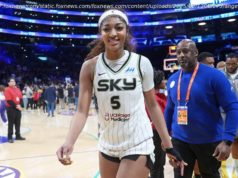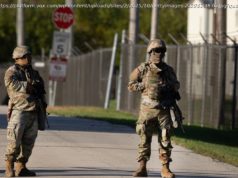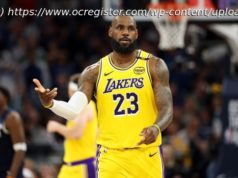Mike Trout has played in one playoff series, won no postseason games. It is not pace of play or protective netting, but the absence of the sport’s best player…
Mike Trout has played in one playoff series, won no postseason games. It is not pace of play or protective netting, but the absence of the sport’s best player from its signature events is a problem; as it would be if, say, LeBron James or Tom Brady were not making it to the playoffs with regularity.
Even 12 months ago it was hard to see how that was going to change, such was the underwhelming state of the Angels’ roster.
But Andrelton Simmons blossomed into a two-way force, Justin Upton was acquired and retained and Josh Hamilton’s albatross contract finally ran out. Then, Friday, in the biggest move yet, Shohei Ohtani announced he had picked the Angels.
It is not just that Ohtani is so talented as both a pitcher and a hitter, it is that he cost so little ($22.86 million in posting fee to the Nippon-Ham Fighters, signing bonus and 2018 minimum major league salary) compared to his talent the Angels comfortably can continue spending to address second base, third base and their bullpen.
That might not close the whole 21-game gap that existed between the champion Astros and the second-place Angels in the AL West last year, but it is not farfetched to think the Angels are now contenders. They are a team that can challenge their more popular neighbor to the northwest, the Dodgers, for hearts and eyeballs and disposable income.
If you are on the East Coast, the phenomenon of seeing if one player can actually both be a hitter and pitcher is likely to attract viewers to some late-night West Coast games. And, hey, the fringe benefit is you get to see Trout. The best player in Japan and the best player, period, together. That is good for the Angels and pretty great for the game, too.
A few other thoughts on the signing:
— The process went fast. A new posting system between Nippon Professional Baseball and MLB was finalized on Dec. 1 and Ohtani was posted that day. He had until midnight Dec. 22 to reach an agreement.
Last Sunday the seven finalists were revealed — and, thus, so were the 23 also-rans, including the Yankees. Ohtani held seven two-hour meetings with the teams on Tuesday and Wednesday at CAA’s Los Angeles offices. And Friday, he announced his decision.
The speed with which it was done is going to leave the impression that Ohtani had some strong feelings about what he wanted from the outset. To dispel that notion, Ohtani’s lead agent, Nez Balelo, said in a statement: “He read every page of every presentation and listened to every word in each meeting, and he was so impressed that it was not an easy choice.”
— The Yankees did not get to even make a face-to-face presentation, but they might have helped the Angels. As Yankees assistant general manager, Billy Eppler went on an annual scouting trip to Japan and fell in love with Ohtani’s abilities. He also was involved in the Yankees’ signing of Masahiro Tanaka, so he had insights into what might and might not work when recruiting a high-level Japanese star. Eppler is now the Angels’ GM.
In his statement, Balelo said Ohtani “felt a true bond with the Angels.” It is clear Eppler was able to make a presentation that resonated with the player.
— Of the seven finalists, the Padres would have provided the lowest-pressure environment for Ohtani to break in because they are viewed as the least likely to contend next year. Thus, Ohtani could get, say, 400-plus plate appearances and 25-ish starts no matter what, whereas a contender might have to strip at-bats from him if he is not hitting.
The Angels, though, might provide the second most comfortable situation. He is close to Los Angeles, without being in Los Angeles. He is on a team that wants to win now, but does not have the pressure to do so in 2018 that, say, the Yankees, Red Sox, Dodgers and Cubs do.
— I think two things you will hear a lot in coming weeks is that the Angels are tinkering with a six-man rotation and Albert Pujols is training to play some more first base.
A six-man rotation would allow Ohtani a more familiar period to prepare for each start with games to be in the lineup in between, similar to what he experienced in Japan. Keep in mind that due to leg injuries, Ohtani threw just 25 ¹/₃ innings last year and has never worked more than 160 ²/₃. But beyond that, Eppler has thought a lot about a six-man rotation anyway. And with other pitchers having had abbreviated 2017 seasons because of injury, notably ace Garrett Richards plus Andrew Heaney, Matt Shoemaker and Tyler Skaggs, the Angels were going to have to consider protecting their rotation regardless of whether they landed Ohtani.
As for Pujols, he has played just 96 games at first base the past three years, just six last year, as mainly damage to his feet has made it harder to play. But at the GM Meetings, Eppler mentioned this was the first offseason in a while in which Pujols can work out regularly without regard to injuries. He turns 38 next month. Can he possibly play even 50-60 games at first to more easily open the DH slot for Ohtani?
Pujols still has four years at $114 million left, but after his worst season in the majors in 2017, he has become a more supplementary player on the Angels and — despite his stature — the one most likely to lose playing time if necessary in favor of Ohtani, especially if the Angels limit Ohtani’s outfield play.
— The Yankees did not get to the second round, yet the big losers in the Ohtani sweepstakes were the Mariners, who on Thursday made another trade to add international bonus money, giving them the most to spend at $3.55 million. They were viewed as the favorite. Yet the team that has gone the longest without making the playoffs (2001) did not land him.






